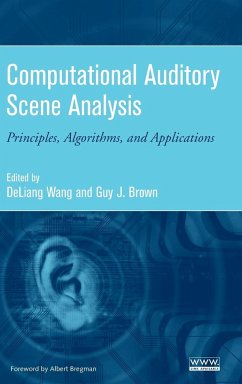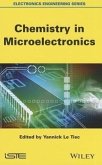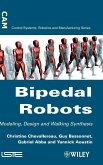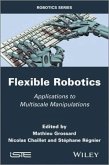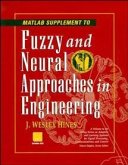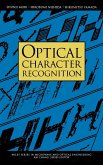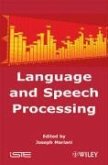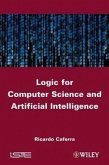Computational Auditory Analysis
Herausgeber: Wang, Deliang; Brown, Guy J
Computational Auditory Analysis
Herausgeber: Wang, Deliang; Brown, Guy J
- Gebundenes Buch
- Merkliste
- Auf die Merkliste
- Bewerten Bewerten
- Teilen
- Produkt teilen
- Produkterinnerung
- Produkterinnerung
How can we engineer systems capable of "cocktail party" listening? Human listeners are able to perceptually segregate one sound source from an acoustic mixture, such as a single voice from a mixture of other voices and music at a busy cocktail party. How can we engineer "machine listening" systems that achieve this perceptual feat? Albert Bregman's book Auditory Scene Analysis, published in 1990, drew an analogy between the perception of auditory scenes and visual scenes, and described a coherent framework for understanding the perceptual organization of sound. His account has stimulated much…mehr
Andere Kunden interessierten sich auch für
![Chemistry in Microelectronics Chemistry in Microelectronics]() Chemistry in Microelectronics164,99 €
Chemistry in Microelectronics164,99 €![Bipedal Robots Bipedal Robots]() Bipedal Robots170,99 €
Bipedal Robots170,99 €![Flexible Robotics Flexible Robotics]() Flexible Robotics182,99 €
Flexible Robotics182,99 €![MATLAB Supplement to Fuzzy and Neural Approaches in Engineering MATLAB Supplement to Fuzzy and Neural Approaches in Engineering]() J Wesley HinesMATLAB Supplement to Fuzzy and Neural Approaches in Engineering75,99 €
J Wesley HinesMATLAB Supplement to Fuzzy and Neural Approaches in Engineering75,99 €![Optical Character Recognition Optical Character Recognition]() Shunji MoriOptical Character Recognition246,99 €
Shunji MoriOptical Character Recognition246,99 €![Language and Speech Processing Language and Speech Processing]() Language and Speech Processing252,99 €
Language and Speech Processing252,99 €![Logic for Computer Science and Artificial Intelligence Logic for Computer Science and Artificial Intelligence]() Ricardo CaferraLogic for Computer Science and Artificial Intelligence225,99 €
Ricardo CaferraLogic for Computer Science and Artificial Intelligence225,99 €-
-
-
How can we engineer systems capable of "cocktail party" listening? Human listeners are able to perceptually segregate one sound source from an acoustic mixture, such as a single voice from a mixture of other voices and music at a busy cocktail party. How can we engineer "machine listening" systems that achieve this perceptual feat? Albert Bregman's book Auditory Scene Analysis, published in 1990, drew an analogy between the perception of auditory scenes and visual scenes, and described a coherent framework for understanding the perceptual organization of sound. His account has stimulated much interest in computational studies of hearing. Such studies are motivated in part by the demand for practical sound separation systems, which have many applications including noise-robust automatic speech recognition, hearing prostheses, and automatic music transcription. This emerging field has become known as computational auditory scene analysis (CASA). Computational Auditory Scene Analysis: Principles, Algorithms, and Applications provides a comprehensive and coherent account of the state of the art in CASA, in terms of the underlying principles, the algorithms and system architectures that are employed, and the potential applications of this exciting new technology. With a Foreword by Bregman, its chapters are written by leading researchers and cover a wide range of topics including: * Estimation of multiple fundamental frequencies * Feature-based and model-based approaches to CASA * Sound separation based on spatial location * Processing for reverberant environments * Segregation of speech and musical signals * Automatic speech recognition in noisy environments * Neural and perceptual modeling of auditory organization The text is written at a level that will be accessible to graduate students and researchers from related science and engineering disciplines. The extensive bibliography accompanying each chapter will also make this book a valuable reference source. A web site accompanying the text (www.casabook.org) features software tools and sound demonstrations.
Produktdetails
- Produktdetails
- Verlag: Wiley
- Seitenzahl: 424
- Erscheinungstermin: 1. Oktober 2006
- Englisch
- Abmessung: 240mm x 161mm x 27mm
- Gewicht: 800g
- ISBN-13: 9780471741091
- ISBN-10: 0471741094
- Artikelnr.: 22057587
- Herstellerkennzeichnung
- Libri GmbH
- Europaallee 1
- 36244 Bad Hersfeld
- gpsr@libri.de
- Verlag: Wiley
- Seitenzahl: 424
- Erscheinungstermin: 1. Oktober 2006
- Englisch
- Abmessung: 240mm x 161mm x 27mm
- Gewicht: 800g
- ISBN-13: 9780471741091
- ISBN-10: 0471741094
- Artikelnr.: 22057587
- Herstellerkennzeichnung
- Libri GmbH
- Europaallee 1
- 36244 Bad Hersfeld
- gpsr@libri.de
Editors DeLIANG WANG and GUY J. BROWN are well-known for their contributions to the development of CASA. Wang is a Professor in the Department of Computer Science and Engineering and the Center for Cognitive Science at The Ohio State University. He is an IEEE Fellow. Brown is a Senior Lecturer in the Department of Computer Science at the University of Sheffield, UK.
Foreword.
Preface.
Contributors.
Acronyms.
1. Fundamentals of Computational Auditory Scene Analysis (DeLiang Wang and
Guy J. Brown).
1.1 Human Auditory Scene Analysis.
1.1.1 Structure and Function of the Auditory System.
1.1.2 Perceptual Organization of Simple Stimuli.
1.1.3 Perceptual Segregation of Speech from Other Sounds.
1.1.4 Perceptual Mechanisms.
1.2 Computational Auditory Scene Analysis (CASA).
1.2.1 What Is CASA?
1.2.2 What Is the Goal of CASA?
1.2.3 Why CASA?
1.3 Basics of CASA Systems.
1.3.1 System Architecture.
1.3.2 Cochleagram.
1.3.3 Correlogram.
1.3.4 Cross-Correlogram.
1.3.5 Time-Frequency Masks.
1.3.6 Resynthesis.
1.4 CASA Evaluation.
1.4.1 Evaluation Criteria.
1.4.2 Corpora.
1.5 Other Sound Separation Approaches.
1.6 A Brief History of CASA (Prior to 2000).
1.6.1 Monaural CASA Systems.
1.6.2 Binaural CASA Systems.
1.6.3 Neural CASA Models.
1.7 Conclusions 36
Acknowledgments.
References.
2. Multiple F0 Estimation (Alain de Cheveigné).
2.1 Introduction.
2.2 Signal Models.
2.3 Single-Voice F0 Estimation.
2.3.1 Spectral Approach.
2.3.2 Temporal Approach.
2.3.3 Spectrotemporal Approach.
2.4 Multiple-Voice F0 Estimation.
2.4.1 Spectral Approach.
2.4.2 Temporal Approach.
2.4.3 Spectrotemporal Approach.
2.5 Issues.
2.5.1 Spectral Resolution.
2.5.2 Temporal Resolution.
2.5.3 Spectrotemporal Resolution.
2.6 Other Sources of Information.
2.6.1 Temporal and Spectral Continuity.
2.6.2 Instrument Models.
2.6.3 Learning-Based Techniques.
2.7 Estimating the Number of Sources.
2.8 Evaluation.
2.9 Application Scenarios.
2.10 Conclusion.
Acknowledgments.
References.
3. Feature-Based Speech Segregation (DeLiang Wang).
3.1 Introduction.
3.2 Feature Extraction.
3.2.1 Pitch Detection.
3.2.2 Onset and Offset Detection.
3.2.3 Amplitude Modulation Extraction.
3.2.4 Frequency Modulation Detection.
3.3 Auditory Segmentation.
3.3.1 What Is the Goal of Auditory Segmentation?
3.3.2 Segmentation Based on Cross-Channel Correlation and Temporal
Continuity.
3.3.3 Segmentation Based on Onset and Offset Analysis.
3.4 Simultaneous Grouping.
3.4.1 Voiced Speech Segregation.
3.4.2 Unvoiced Speech Segregation.
3.5 Sequential Grouping.
3.5.1 Spectrum-Based Sequential Grouping.
3.5.2 Pitch-Based Sequential Grouping.
3.5.3 Model-Based Sequential Grouping.
3.6 Discussion.
Acknowledgments.
References.
4. Model-Based Scene Analysis (Daniel P. W. Ellis).
4.1 Introduction.
4.2 Source Separation as Inference.
4.3 Hidden Markov Models.
4.4 Aspects of Model-Based Systems.
4.4.1 Constraints: Types and Representations.
4.4.2 Fitting Models.
4.4.3 Generating Output.
4.5 Discussion.
4.5.1 Unknown Interference.
4.5.2 Ambiguity and Adaptation.
4.5.3 Relations to Other Separation Approaches.
4.6 Conclusions.
References.
5. Binaural Sound Localization (Richard M. Stern, Guy J. Brown, and DeLiang
Wang).
5.1 Introduction.
5.2 Physical and Physiological Mechanisms Underlying Auditory Localization.
5.2.1 Physical Cues.
5.2.2 Physiological Estimation of ITD and IID.
5.3 Spatial Perception of Single Sources.
5.3.1 Sensitivity to Differences in Interaural Time and Intensity.
5.3.2 Lateralization of Single Sources.
5.3.3 Localization of Single Sources.
5.3.4 The Precedence Effect.
5.4 Spatial Perception of Multiple Sources.
5.4.1 Localization of Multiple Sources.
5.4.2 Binaural Signal Detection.
5.5 Models of Binaural Perception.
5.5.1 Classical Models of Binaural Hearing.
5.5.2 Cross-Correlation-Based Models of Binaural Interaction.
5.5.3 Some Extensions to Cross-Correlation-Based Binaural Models.
5.6 Multisource Sound Localization.
5.6.1 Estimating Source Azimuth from Interaural Cross-Correlation.
5.6.2 Methods for Resolving Azimuth Ambiguity.
5.6.3 Localization of Moving Sources.
5.7 General Discussion.
Acknowledgments.
References.
6. Localization-Based Grouping (Albert S. Feng and Douglas L. Jones).
6.1 Introduction.
6.2 Classical Beamforming Techniques.
6.2.1 Fixed Beamforming Techniques.
6.2.2 Adaptive Beamforming Techniques.
6.2.3 Independent Component Analysis Techniques.
6.2.4 Other Localization-Based Techniques.
6.3 Location-Based Grouping Using Interaural Time Difference Cue.
6.4 Location-Based Grouping Using Interaural Intensity Difference Cue.
6.5 Location-Based Grouping Using Multiple Binaural Cues.
6.6 Discussion and Conclusions.
Acknowledgments.
References.
7. Reverberation (Guy J. Brown and Kalle J. Palomäki).
7.1 Introduction.
7.2 Effects of Reverberation on Listeners.
7.2.1 Speech Perception.
7.2.2 Sound Localization.
7.2.3 Source Separation and Signal Detection.
7.2.4 Distance Perception.
7.2.5 Auditory Spatial Impression.
7.3 Effects of Reverberation on Machines.
7.4 Mechanisms Underlying Robustness to Reverberation in Human Listeners.
7.4.1 The Role of Slow Temporal Modulations in Speech Perception.
7.4.2 The Binaural Advantage.
7.4.3 The Precedence Effect.
7.4.4 Perceptual Compensation for Spectral Envelope Distortion.
7.5 Reverberation-Robust Acoustic Processing.
7.5.1 Dereverberation.
7.5.2 Reverberation-Robust Acoustic Features.
7.5.3 Reverberation Masking.
7.6 CASA and Reverberation.
7.6.1 Systems Based on Directional Filtering.
7.6.2 CASA for Robust ASR in Reverberant Conditions.
7.6.3 Systems that Use Multiple Cues.
7.7 Discussion and Conclusions.
Acknowledgments.
References.
8. Analysis of Musical Audio Signals (Masataka Goto).
8.1 Introduction.
8.2 Music Scene Description.
8.2.1 Music Scene Descriptions.
8.2.2 Difficulties Associated with Musical Audio Signals.
8.3 Estimating Melody and Bass Lines.
8.3.1 PreFEst-front-end: Forming the Observed Probability Density
Functions.
8.3.2 PreFEst-core: Estimating the F0's Probability Density Function.
8.3.3 PreFEst-back-end: Sequential F0 Tracking by Multiple-Agent
Architecture.
8.3.4 Other Methods.
8.4 Estimating Beat Structure.
8.4.1 Estimating Period and Phase.
8.4.2 Dealing with Ambiguity.
8.4.3 Using Musical Knowledge.
8.5 Estimating Chorus Sections and Repeated Sections.
8.5.1 Extracting Acoustic Features and Calculating Their Similarity.
8.5.2 Finding Repeated Sections.
8.5.3 Grouping Repeated Sections.
8.5.4 Detecting Modulated Repetition.
8.5.5 Selecting Chorus Sections.
8.5.6 Other Methods.
8.6 Discussion and Conclusions.
8.6.1 Importance.
8.6.2 Evaluation Issues.
8.6.3 Future Directions.
References.
9. Robust Automatic Speech Recognition (Jon Barker).
9.1 Introduction.
9.2 ASA and Speech Perception in Humans.
9.2.1 Speech Perception and Simultaneous Grouping.
9.2.2 Speech Perception and Sequential Grouping.
9.2.3 Speech Schemes.
9.2.4 Challenges to the ASA Account of Speech Perception.
9.2.5 Interim Summary.
9.3 Speech Recognition by Machine.
9.3.1 The Statistical Basis of ASR.
9.3.2 Traditional Approaches to Robust ASR.
9.3.3 CASA-Driven Approaches to ASR.
9.4 Primitive CASA and ASR.
9.4.1 Speech and Time-Frequency Masking.
9.4.2 The Missing-Data Approach to ASR.
9.4.3 Marginalization-Based Missing-Data ASR Systems.
9.4.4 Imputation-Based Missing-Data Solutions.
9.4.5 Estimating the Missing-Data Mask.
9.4.6 Difficulties with the Missing-Data Approach.
9.5 Model-Based CASA and ASR.
9.5.1 The Speech Fragment Decoding Framework.
9.5.2 Coupling Source Segregation and Recognition.
9.6 Discussion and Conclusions.
9.7 Concluding Remarks.
References.
10. Neural and Perceptual Modeling (Guy J. Brown and DeLiang Wang).
10.1 Introduction.
10.2 The Neural Basis of Auditory Grouping.
10.2.1 Theoretical Solutions to the Binding Problem.
10.2.2 Empirical Results on Binding and ASA.
10.3 Models of Individual Neurons.
10.3.1 Relaxation Oscillators.
10.3.2 Spike Oscillators.
10.3.3 A Model of a Specific Auditory Neuron.
10.4 Models of Specific Perceptual Phenomena.
10.4.1 Perceptual Streaming of Tone Sequences.
10.4.2 Perceptual Segregation of Concurrent Vowels with Different F0s.
10.5 The Oscillatory Correlation Framework for CASA.
10.5.1 Speech Segregation Based on Oscillatory Correlation.
10.6 Schema-Driven Grouping.
10.7 Discussion.
10.7.1 Temporal or Spatial Coding of Auditory Grouping.
10.7.2 Physiological Support for Neural Time Delays.
10.7.3 Convergence of Psychological, Physiological, and Computational
Approaches.
10.7.4 Neural Models as a Framework for CASA.
10.7.5 The Role of Attention.
10.7.6 Schema-Based Organization.
Acknowledgments.
References.
Index.
Preface.
Contributors.
Acronyms.
1. Fundamentals of Computational Auditory Scene Analysis (DeLiang Wang and
Guy J. Brown).
1.1 Human Auditory Scene Analysis.
1.1.1 Structure and Function of the Auditory System.
1.1.2 Perceptual Organization of Simple Stimuli.
1.1.3 Perceptual Segregation of Speech from Other Sounds.
1.1.4 Perceptual Mechanisms.
1.2 Computational Auditory Scene Analysis (CASA).
1.2.1 What Is CASA?
1.2.2 What Is the Goal of CASA?
1.2.3 Why CASA?
1.3 Basics of CASA Systems.
1.3.1 System Architecture.
1.3.2 Cochleagram.
1.3.3 Correlogram.
1.3.4 Cross-Correlogram.
1.3.5 Time-Frequency Masks.
1.3.6 Resynthesis.
1.4 CASA Evaluation.
1.4.1 Evaluation Criteria.
1.4.2 Corpora.
1.5 Other Sound Separation Approaches.
1.6 A Brief History of CASA (Prior to 2000).
1.6.1 Monaural CASA Systems.
1.6.2 Binaural CASA Systems.
1.6.3 Neural CASA Models.
1.7 Conclusions 36
Acknowledgments.
References.
2. Multiple F0 Estimation (Alain de Cheveigné).
2.1 Introduction.
2.2 Signal Models.
2.3 Single-Voice F0 Estimation.
2.3.1 Spectral Approach.
2.3.2 Temporal Approach.
2.3.3 Spectrotemporal Approach.
2.4 Multiple-Voice F0 Estimation.
2.4.1 Spectral Approach.
2.4.2 Temporal Approach.
2.4.3 Spectrotemporal Approach.
2.5 Issues.
2.5.1 Spectral Resolution.
2.5.2 Temporal Resolution.
2.5.3 Spectrotemporal Resolution.
2.6 Other Sources of Information.
2.6.1 Temporal and Spectral Continuity.
2.6.2 Instrument Models.
2.6.3 Learning-Based Techniques.
2.7 Estimating the Number of Sources.
2.8 Evaluation.
2.9 Application Scenarios.
2.10 Conclusion.
Acknowledgments.
References.
3. Feature-Based Speech Segregation (DeLiang Wang).
3.1 Introduction.
3.2 Feature Extraction.
3.2.1 Pitch Detection.
3.2.2 Onset and Offset Detection.
3.2.3 Amplitude Modulation Extraction.
3.2.4 Frequency Modulation Detection.
3.3 Auditory Segmentation.
3.3.1 What Is the Goal of Auditory Segmentation?
3.3.2 Segmentation Based on Cross-Channel Correlation and Temporal
Continuity.
3.3.3 Segmentation Based on Onset and Offset Analysis.
3.4 Simultaneous Grouping.
3.4.1 Voiced Speech Segregation.
3.4.2 Unvoiced Speech Segregation.
3.5 Sequential Grouping.
3.5.1 Spectrum-Based Sequential Grouping.
3.5.2 Pitch-Based Sequential Grouping.
3.5.3 Model-Based Sequential Grouping.
3.6 Discussion.
Acknowledgments.
References.
4. Model-Based Scene Analysis (Daniel P. W. Ellis).
4.1 Introduction.
4.2 Source Separation as Inference.
4.3 Hidden Markov Models.
4.4 Aspects of Model-Based Systems.
4.4.1 Constraints: Types and Representations.
4.4.2 Fitting Models.
4.4.3 Generating Output.
4.5 Discussion.
4.5.1 Unknown Interference.
4.5.2 Ambiguity and Adaptation.
4.5.3 Relations to Other Separation Approaches.
4.6 Conclusions.
References.
5. Binaural Sound Localization (Richard M. Stern, Guy J. Brown, and DeLiang
Wang).
5.1 Introduction.
5.2 Physical and Physiological Mechanisms Underlying Auditory Localization.
5.2.1 Physical Cues.
5.2.2 Physiological Estimation of ITD and IID.
5.3 Spatial Perception of Single Sources.
5.3.1 Sensitivity to Differences in Interaural Time and Intensity.
5.3.2 Lateralization of Single Sources.
5.3.3 Localization of Single Sources.
5.3.4 The Precedence Effect.
5.4 Spatial Perception of Multiple Sources.
5.4.1 Localization of Multiple Sources.
5.4.2 Binaural Signal Detection.
5.5 Models of Binaural Perception.
5.5.1 Classical Models of Binaural Hearing.
5.5.2 Cross-Correlation-Based Models of Binaural Interaction.
5.5.3 Some Extensions to Cross-Correlation-Based Binaural Models.
5.6 Multisource Sound Localization.
5.6.1 Estimating Source Azimuth from Interaural Cross-Correlation.
5.6.2 Methods for Resolving Azimuth Ambiguity.
5.6.3 Localization of Moving Sources.
5.7 General Discussion.
Acknowledgments.
References.
6. Localization-Based Grouping (Albert S. Feng and Douglas L. Jones).
6.1 Introduction.
6.2 Classical Beamforming Techniques.
6.2.1 Fixed Beamforming Techniques.
6.2.2 Adaptive Beamforming Techniques.
6.2.3 Independent Component Analysis Techniques.
6.2.4 Other Localization-Based Techniques.
6.3 Location-Based Grouping Using Interaural Time Difference Cue.
6.4 Location-Based Grouping Using Interaural Intensity Difference Cue.
6.5 Location-Based Grouping Using Multiple Binaural Cues.
6.6 Discussion and Conclusions.
Acknowledgments.
References.
7. Reverberation (Guy J. Brown and Kalle J. Palomäki).
7.1 Introduction.
7.2 Effects of Reverberation on Listeners.
7.2.1 Speech Perception.
7.2.2 Sound Localization.
7.2.3 Source Separation and Signal Detection.
7.2.4 Distance Perception.
7.2.5 Auditory Spatial Impression.
7.3 Effects of Reverberation on Machines.
7.4 Mechanisms Underlying Robustness to Reverberation in Human Listeners.
7.4.1 The Role of Slow Temporal Modulations in Speech Perception.
7.4.2 The Binaural Advantage.
7.4.3 The Precedence Effect.
7.4.4 Perceptual Compensation for Spectral Envelope Distortion.
7.5 Reverberation-Robust Acoustic Processing.
7.5.1 Dereverberation.
7.5.2 Reverberation-Robust Acoustic Features.
7.5.3 Reverberation Masking.
7.6 CASA and Reverberation.
7.6.1 Systems Based on Directional Filtering.
7.6.2 CASA for Robust ASR in Reverberant Conditions.
7.6.3 Systems that Use Multiple Cues.
7.7 Discussion and Conclusions.
Acknowledgments.
References.
8. Analysis of Musical Audio Signals (Masataka Goto).
8.1 Introduction.
8.2 Music Scene Description.
8.2.1 Music Scene Descriptions.
8.2.2 Difficulties Associated with Musical Audio Signals.
8.3 Estimating Melody and Bass Lines.
8.3.1 PreFEst-front-end: Forming the Observed Probability Density
Functions.
8.3.2 PreFEst-core: Estimating the F0's Probability Density Function.
8.3.3 PreFEst-back-end: Sequential F0 Tracking by Multiple-Agent
Architecture.
8.3.4 Other Methods.
8.4 Estimating Beat Structure.
8.4.1 Estimating Period and Phase.
8.4.2 Dealing with Ambiguity.
8.4.3 Using Musical Knowledge.
8.5 Estimating Chorus Sections and Repeated Sections.
8.5.1 Extracting Acoustic Features and Calculating Their Similarity.
8.5.2 Finding Repeated Sections.
8.5.3 Grouping Repeated Sections.
8.5.4 Detecting Modulated Repetition.
8.5.5 Selecting Chorus Sections.
8.5.6 Other Methods.
8.6 Discussion and Conclusions.
8.6.1 Importance.
8.6.2 Evaluation Issues.
8.6.3 Future Directions.
References.
9. Robust Automatic Speech Recognition (Jon Barker).
9.1 Introduction.
9.2 ASA and Speech Perception in Humans.
9.2.1 Speech Perception and Simultaneous Grouping.
9.2.2 Speech Perception and Sequential Grouping.
9.2.3 Speech Schemes.
9.2.4 Challenges to the ASA Account of Speech Perception.
9.2.5 Interim Summary.
9.3 Speech Recognition by Machine.
9.3.1 The Statistical Basis of ASR.
9.3.2 Traditional Approaches to Robust ASR.
9.3.3 CASA-Driven Approaches to ASR.
9.4 Primitive CASA and ASR.
9.4.1 Speech and Time-Frequency Masking.
9.4.2 The Missing-Data Approach to ASR.
9.4.3 Marginalization-Based Missing-Data ASR Systems.
9.4.4 Imputation-Based Missing-Data Solutions.
9.4.5 Estimating the Missing-Data Mask.
9.4.6 Difficulties with the Missing-Data Approach.
9.5 Model-Based CASA and ASR.
9.5.1 The Speech Fragment Decoding Framework.
9.5.2 Coupling Source Segregation and Recognition.
9.6 Discussion and Conclusions.
9.7 Concluding Remarks.
References.
10. Neural and Perceptual Modeling (Guy J. Brown and DeLiang Wang).
10.1 Introduction.
10.2 The Neural Basis of Auditory Grouping.
10.2.1 Theoretical Solutions to the Binding Problem.
10.2.2 Empirical Results on Binding and ASA.
10.3 Models of Individual Neurons.
10.3.1 Relaxation Oscillators.
10.3.2 Spike Oscillators.
10.3.3 A Model of a Specific Auditory Neuron.
10.4 Models of Specific Perceptual Phenomena.
10.4.1 Perceptual Streaming of Tone Sequences.
10.4.2 Perceptual Segregation of Concurrent Vowels with Different F0s.
10.5 The Oscillatory Correlation Framework for CASA.
10.5.1 Speech Segregation Based on Oscillatory Correlation.
10.6 Schema-Driven Grouping.
10.7 Discussion.
10.7.1 Temporal or Spatial Coding of Auditory Grouping.
10.7.2 Physiological Support for Neural Time Delays.
10.7.3 Convergence of Psychological, Physiological, and Computational
Approaches.
10.7.4 Neural Models as a Framework for CASA.
10.7.5 The Role of Attention.
10.7.6 Schema-Based Organization.
Acknowledgments.
References.
Index.
Foreword.
Preface.
Contributors.
Acronyms.
1. Fundamentals of Computational Auditory Scene Analysis (DeLiang Wang and
Guy J. Brown).
1.1 Human Auditory Scene Analysis.
1.1.1 Structure and Function of the Auditory System.
1.1.2 Perceptual Organization of Simple Stimuli.
1.1.3 Perceptual Segregation of Speech from Other Sounds.
1.1.4 Perceptual Mechanisms.
1.2 Computational Auditory Scene Analysis (CASA).
1.2.1 What Is CASA?
1.2.2 What Is the Goal of CASA?
1.2.3 Why CASA?
1.3 Basics of CASA Systems.
1.3.1 System Architecture.
1.3.2 Cochleagram.
1.3.3 Correlogram.
1.3.4 Cross-Correlogram.
1.3.5 Time-Frequency Masks.
1.3.6 Resynthesis.
1.4 CASA Evaluation.
1.4.1 Evaluation Criteria.
1.4.2 Corpora.
1.5 Other Sound Separation Approaches.
1.6 A Brief History of CASA (Prior to 2000).
1.6.1 Monaural CASA Systems.
1.6.2 Binaural CASA Systems.
1.6.3 Neural CASA Models.
1.7 Conclusions 36
Acknowledgments.
References.
2. Multiple F0 Estimation (Alain de Cheveigné).
2.1 Introduction.
2.2 Signal Models.
2.3 Single-Voice F0 Estimation.
2.3.1 Spectral Approach.
2.3.2 Temporal Approach.
2.3.3 Spectrotemporal Approach.
2.4 Multiple-Voice F0 Estimation.
2.4.1 Spectral Approach.
2.4.2 Temporal Approach.
2.4.3 Spectrotemporal Approach.
2.5 Issues.
2.5.1 Spectral Resolution.
2.5.2 Temporal Resolution.
2.5.3 Spectrotemporal Resolution.
2.6 Other Sources of Information.
2.6.1 Temporal and Spectral Continuity.
2.6.2 Instrument Models.
2.6.3 Learning-Based Techniques.
2.7 Estimating the Number of Sources.
2.8 Evaluation.
2.9 Application Scenarios.
2.10 Conclusion.
Acknowledgments.
References.
3. Feature-Based Speech Segregation (DeLiang Wang).
3.1 Introduction.
3.2 Feature Extraction.
3.2.1 Pitch Detection.
3.2.2 Onset and Offset Detection.
3.2.3 Amplitude Modulation Extraction.
3.2.4 Frequency Modulation Detection.
3.3 Auditory Segmentation.
3.3.1 What Is the Goal of Auditory Segmentation?
3.3.2 Segmentation Based on Cross-Channel Correlation and Temporal
Continuity.
3.3.3 Segmentation Based on Onset and Offset Analysis.
3.4 Simultaneous Grouping.
3.4.1 Voiced Speech Segregation.
3.4.2 Unvoiced Speech Segregation.
3.5 Sequential Grouping.
3.5.1 Spectrum-Based Sequential Grouping.
3.5.2 Pitch-Based Sequential Grouping.
3.5.3 Model-Based Sequential Grouping.
3.6 Discussion.
Acknowledgments.
References.
4. Model-Based Scene Analysis (Daniel P. W. Ellis).
4.1 Introduction.
4.2 Source Separation as Inference.
4.3 Hidden Markov Models.
4.4 Aspects of Model-Based Systems.
4.4.1 Constraints: Types and Representations.
4.4.2 Fitting Models.
4.4.3 Generating Output.
4.5 Discussion.
4.5.1 Unknown Interference.
4.5.2 Ambiguity and Adaptation.
4.5.3 Relations to Other Separation Approaches.
4.6 Conclusions.
References.
5. Binaural Sound Localization (Richard M. Stern, Guy J. Brown, and DeLiang
Wang).
5.1 Introduction.
5.2 Physical and Physiological Mechanisms Underlying Auditory Localization.
5.2.1 Physical Cues.
5.2.2 Physiological Estimation of ITD and IID.
5.3 Spatial Perception of Single Sources.
5.3.1 Sensitivity to Differences in Interaural Time and Intensity.
5.3.2 Lateralization of Single Sources.
5.3.3 Localization of Single Sources.
5.3.4 The Precedence Effect.
5.4 Spatial Perception of Multiple Sources.
5.4.1 Localization of Multiple Sources.
5.4.2 Binaural Signal Detection.
5.5 Models of Binaural Perception.
5.5.1 Classical Models of Binaural Hearing.
5.5.2 Cross-Correlation-Based Models of Binaural Interaction.
5.5.3 Some Extensions to Cross-Correlation-Based Binaural Models.
5.6 Multisource Sound Localization.
5.6.1 Estimating Source Azimuth from Interaural Cross-Correlation.
5.6.2 Methods for Resolving Azimuth Ambiguity.
5.6.3 Localization of Moving Sources.
5.7 General Discussion.
Acknowledgments.
References.
6. Localization-Based Grouping (Albert S. Feng and Douglas L. Jones).
6.1 Introduction.
6.2 Classical Beamforming Techniques.
6.2.1 Fixed Beamforming Techniques.
6.2.2 Adaptive Beamforming Techniques.
6.2.3 Independent Component Analysis Techniques.
6.2.4 Other Localization-Based Techniques.
6.3 Location-Based Grouping Using Interaural Time Difference Cue.
6.4 Location-Based Grouping Using Interaural Intensity Difference Cue.
6.5 Location-Based Grouping Using Multiple Binaural Cues.
6.6 Discussion and Conclusions.
Acknowledgments.
References.
7. Reverberation (Guy J. Brown and Kalle J. Palomäki).
7.1 Introduction.
7.2 Effects of Reverberation on Listeners.
7.2.1 Speech Perception.
7.2.2 Sound Localization.
7.2.3 Source Separation and Signal Detection.
7.2.4 Distance Perception.
7.2.5 Auditory Spatial Impression.
7.3 Effects of Reverberation on Machines.
7.4 Mechanisms Underlying Robustness to Reverberation in Human Listeners.
7.4.1 The Role of Slow Temporal Modulations in Speech Perception.
7.4.2 The Binaural Advantage.
7.4.3 The Precedence Effect.
7.4.4 Perceptual Compensation for Spectral Envelope Distortion.
7.5 Reverberation-Robust Acoustic Processing.
7.5.1 Dereverberation.
7.5.2 Reverberation-Robust Acoustic Features.
7.5.3 Reverberation Masking.
7.6 CASA and Reverberation.
7.6.1 Systems Based on Directional Filtering.
7.6.2 CASA for Robust ASR in Reverberant Conditions.
7.6.3 Systems that Use Multiple Cues.
7.7 Discussion and Conclusions.
Acknowledgments.
References.
8. Analysis of Musical Audio Signals (Masataka Goto).
8.1 Introduction.
8.2 Music Scene Description.
8.2.1 Music Scene Descriptions.
8.2.2 Difficulties Associated with Musical Audio Signals.
8.3 Estimating Melody and Bass Lines.
8.3.1 PreFEst-front-end: Forming the Observed Probability Density
Functions.
8.3.2 PreFEst-core: Estimating the F0's Probability Density Function.
8.3.3 PreFEst-back-end: Sequential F0 Tracking by Multiple-Agent
Architecture.
8.3.4 Other Methods.
8.4 Estimating Beat Structure.
8.4.1 Estimating Period and Phase.
8.4.2 Dealing with Ambiguity.
8.4.3 Using Musical Knowledge.
8.5 Estimating Chorus Sections and Repeated Sections.
8.5.1 Extracting Acoustic Features and Calculating Their Similarity.
8.5.2 Finding Repeated Sections.
8.5.3 Grouping Repeated Sections.
8.5.4 Detecting Modulated Repetition.
8.5.5 Selecting Chorus Sections.
8.5.6 Other Methods.
8.6 Discussion and Conclusions.
8.6.1 Importance.
8.6.2 Evaluation Issues.
8.6.3 Future Directions.
References.
9. Robust Automatic Speech Recognition (Jon Barker).
9.1 Introduction.
9.2 ASA and Speech Perception in Humans.
9.2.1 Speech Perception and Simultaneous Grouping.
9.2.2 Speech Perception and Sequential Grouping.
9.2.3 Speech Schemes.
9.2.4 Challenges to the ASA Account of Speech Perception.
9.2.5 Interim Summary.
9.3 Speech Recognition by Machine.
9.3.1 The Statistical Basis of ASR.
9.3.2 Traditional Approaches to Robust ASR.
9.3.3 CASA-Driven Approaches to ASR.
9.4 Primitive CASA and ASR.
9.4.1 Speech and Time-Frequency Masking.
9.4.2 The Missing-Data Approach to ASR.
9.4.3 Marginalization-Based Missing-Data ASR Systems.
9.4.4 Imputation-Based Missing-Data Solutions.
9.4.5 Estimating the Missing-Data Mask.
9.4.6 Difficulties with the Missing-Data Approach.
9.5 Model-Based CASA and ASR.
9.5.1 The Speech Fragment Decoding Framework.
9.5.2 Coupling Source Segregation and Recognition.
9.6 Discussion and Conclusions.
9.7 Concluding Remarks.
References.
10. Neural and Perceptual Modeling (Guy J. Brown and DeLiang Wang).
10.1 Introduction.
10.2 The Neural Basis of Auditory Grouping.
10.2.1 Theoretical Solutions to the Binding Problem.
10.2.2 Empirical Results on Binding and ASA.
10.3 Models of Individual Neurons.
10.3.1 Relaxation Oscillators.
10.3.2 Spike Oscillators.
10.3.3 A Model of a Specific Auditory Neuron.
10.4 Models of Specific Perceptual Phenomena.
10.4.1 Perceptual Streaming of Tone Sequences.
10.4.2 Perceptual Segregation of Concurrent Vowels with Different F0s.
10.5 The Oscillatory Correlation Framework for CASA.
10.5.1 Speech Segregation Based on Oscillatory Correlation.
10.6 Schema-Driven Grouping.
10.7 Discussion.
10.7.1 Temporal or Spatial Coding of Auditory Grouping.
10.7.2 Physiological Support for Neural Time Delays.
10.7.3 Convergence of Psychological, Physiological, and Computational
Approaches.
10.7.4 Neural Models as a Framework for CASA.
10.7.5 The Role of Attention.
10.7.6 Schema-Based Organization.
Acknowledgments.
References.
Index.
Preface.
Contributors.
Acronyms.
1. Fundamentals of Computational Auditory Scene Analysis (DeLiang Wang and
Guy J. Brown).
1.1 Human Auditory Scene Analysis.
1.1.1 Structure and Function of the Auditory System.
1.1.2 Perceptual Organization of Simple Stimuli.
1.1.3 Perceptual Segregation of Speech from Other Sounds.
1.1.4 Perceptual Mechanisms.
1.2 Computational Auditory Scene Analysis (CASA).
1.2.1 What Is CASA?
1.2.2 What Is the Goal of CASA?
1.2.3 Why CASA?
1.3 Basics of CASA Systems.
1.3.1 System Architecture.
1.3.2 Cochleagram.
1.3.3 Correlogram.
1.3.4 Cross-Correlogram.
1.3.5 Time-Frequency Masks.
1.3.6 Resynthesis.
1.4 CASA Evaluation.
1.4.1 Evaluation Criteria.
1.4.2 Corpora.
1.5 Other Sound Separation Approaches.
1.6 A Brief History of CASA (Prior to 2000).
1.6.1 Monaural CASA Systems.
1.6.2 Binaural CASA Systems.
1.6.3 Neural CASA Models.
1.7 Conclusions 36
Acknowledgments.
References.
2. Multiple F0 Estimation (Alain de Cheveigné).
2.1 Introduction.
2.2 Signal Models.
2.3 Single-Voice F0 Estimation.
2.3.1 Spectral Approach.
2.3.2 Temporal Approach.
2.3.3 Spectrotemporal Approach.
2.4 Multiple-Voice F0 Estimation.
2.4.1 Spectral Approach.
2.4.2 Temporal Approach.
2.4.3 Spectrotemporal Approach.
2.5 Issues.
2.5.1 Spectral Resolution.
2.5.2 Temporal Resolution.
2.5.3 Spectrotemporal Resolution.
2.6 Other Sources of Information.
2.6.1 Temporal and Spectral Continuity.
2.6.2 Instrument Models.
2.6.3 Learning-Based Techniques.
2.7 Estimating the Number of Sources.
2.8 Evaluation.
2.9 Application Scenarios.
2.10 Conclusion.
Acknowledgments.
References.
3. Feature-Based Speech Segregation (DeLiang Wang).
3.1 Introduction.
3.2 Feature Extraction.
3.2.1 Pitch Detection.
3.2.2 Onset and Offset Detection.
3.2.3 Amplitude Modulation Extraction.
3.2.4 Frequency Modulation Detection.
3.3 Auditory Segmentation.
3.3.1 What Is the Goal of Auditory Segmentation?
3.3.2 Segmentation Based on Cross-Channel Correlation and Temporal
Continuity.
3.3.3 Segmentation Based on Onset and Offset Analysis.
3.4 Simultaneous Grouping.
3.4.1 Voiced Speech Segregation.
3.4.2 Unvoiced Speech Segregation.
3.5 Sequential Grouping.
3.5.1 Spectrum-Based Sequential Grouping.
3.5.2 Pitch-Based Sequential Grouping.
3.5.3 Model-Based Sequential Grouping.
3.6 Discussion.
Acknowledgments.
References.
4. Model-Based Scene Analysis (Daniel P. W. Ellis).
4.1 Introduction.
4.2 Source Separation as Inference.
4.3 Hidden Markov Models.
4.4 Aspects of Model-Based Systems.
4.4.1 Constraints: Types and Representations.
4.4.2 Fitting Models.
4.4.3 Generating Output.
4.5 Discussion.
4.5.1 Unknown Interference.
4.5.2 Ambiguity and Adaptation.
4.5.3 Relations to Other Separation Approaches.
4.6 Conclusions.
References.
5. Binaural Sound Localization (Richard M. Stern, Guy J. Brown, and DeLiang
Wang).
5.1 Introduction.
5.2 Physical and Physiological Mechanisms Underlying Auditory Localization.
5.2.1 Physical Cues.
5.2.2 Physiological Estimation of ITD and IID.
5.3 Spatial Perception of Single Sources.
5.3.1 Sensitivity to Differences in Interaural Time and Intensity.
5.3.2 Lateralization of Single Sources.
5.3.3 Localization of Single Sources.
5.3.4 The Precedence Effect.
5.4 Spatial Perception of Multiple Sources.
5.4.1 Localization of Multiple Sources.
5.4.2 Binaural Signal Detection.
5.5 Models of Binaural Perception.
5.5.1 Classical Models of Binaural Hearing.
5.5.2 Cross-Correlation-Based Models of Binaural Interaction.
5.5.3 Some Extensions to Cross-Correlation-Based Binaural Models.
5.6 Multisource Sound Localization.
5.6.1 Estimating Source Azimuth from Interaural Cross-Correlation.
5.6.2 Methods for Resolving Azimuth Ambiguity.
5.6.3 Localization of Moving Sources.
5.7 General Discussion.
Acknowledgments.
References.
6. Localization-Based Grouping (Albert S. Feng and Douglas L. Jones).
6.1 Introduction.
6.2 Classical Beamforming Techniques.
6.2.1 Fixed Beamforming Techniques.
6.2.2 Adaptive Beamforming Techniques.
6.2.3 Independent Component Analysis Techniques.
6.2.4 Other Localization-Based Techniques.
6.3 Location-Based Grouping Using Interaural Time Difference Cue.
6.4 Location-Based Grouping Using Interaural Intensity Difference Cue.
6.5 Location-Based Grouping Using Multiple Binaural Cues.
6.6 Discussion and Conclusions.
Acknowledgments.
References.
7. Reverberation (Guy J. Brown and Kalle J. Palomäki).
7.1 Introduction.
7.2 Effects of Reverberation on Listeners.
7.2.1 Speech Perception.
7.2.2 Sound Localization.
7.2.3 Source Separation and Signal Detection.
7.2.4 Distance Perception.
7.2.5 Auditory Spatial Impression.
7.3 Effects of Reverberation on Machines.
7.4 Mechanisms Underlying Robustness to Reverberation in Human Listeners.
7.4.1 The Role of Slow Temporal Modulations in Speech Perception.
7.4.2 The Binaural Advantage.
7.4.3 The Precedence Effect.
7.4.4 Perceptual Compensation for Spectral Envelope Distortion.
7.5 Reverberation-Robust Acoustic Processing.
7.5.1 Dereverberation.
7.5.2 Reverberation-Robust Acoustic Features.
7.5.3 Reverberation Masking.
7.6 CASA and Reverberation.
7.6.1 Systems Based on Directional Filtering.
7.6.2 CASA for Robust ASR in Reverberant Conditions.
7.6.3 Systems that Use Multiple Cues.
7.7 Discussion and Conclusions.
Acknowledgments.
References.
8. Analysis of Musical Audio Signals (Masataka Goto).
8.1 Introduction.
8.2 Music Scene Description.
8.2.1 Music Scene Descriptions.
8.2.2 Difficulties Associated with Musical Audio Signals.
8.3 Estimating Melody and Bass Lines.
8.3.1 PreFEst-front-end: Forming the Observed Probability Density
Functions.
8.3.2 PreFEst-core: Estimating the F0's Probability Density Function.
8.3.3 PreFEst-back-end: Sequential F0 Tracking by Multiple-Agent
Architecture.
8.3.4 Other Methods.
8.4 Estimating Beat Structure.
8.4.1 Estimating Period and Phase.
8.4.2 Dealing with Ambiguity.
8.4.3 Using Musical Knowledge.
8.5 Estimating Chorus Sections and Repeated Sections.
8.5.1 Extracting Acoustic Features and Calculating Their Similarity.
8.5.2 Finding Repeated Sections.
8.5.3 Grouping Repeated Sections.
8.5.4 Detecting Modulated Repetition.
8.5.5 Selecting Chorus Sections.
8.5.6 Other Methods.
8.6 Discussion and Conclusions.
8.6.1 Importance.
8.6.2 Evaluation Issues.
8.6.3 Future Directions.
References.
9. Robust Automatic Speech Recognition (Jon Barker).
9.1 Introduction.
9.2 ASA and Speech Perception in Humans.
9.2.1 Speech Perception and Simultaneous Grouping.
9.2.2 Speech Perception and Sequential Grouping.
9.2.3 Speech Schemes.
9.2.4 Challenges to the ASA Account of Speech Perception.
9.2.5 Interim Summary.
9.3 Speech Recognition by Machine.
9.3.1 The Statistical Basis of ASR.
9.3.2 Traditional Approaches to Robust ASR.
9.3.3 CASA-Driven Approaches to ASR.
9.4 Primitive CASA and ASR.
9.4.1 Speech and Time-Frequency Masking.
9.4.2 The Missing-Data Approach to ASR.
9.4.3 Marginalization-Based Missing-Data ASR Systems.
9.4.4 Imputation-Based Missing-Data Solutions.
9.4.5 Estimating the Missing-Data Mask.
9.4.6 Difficulties with the Missing-Data Approach.
9.5 Model-Based CASA and ASR.
9.5.1 The Speech Fragment Decoding Framework.
9.5.2 Coupling Source Segregation and Recognition.
9.6 Discussion and Conclusions.
9.7 Concluding Remarks.
References.
10. Neural and Perceptual Modeling (Guy J. Brown and DeLiang Wang).
10.1 Introduction.
10.2 The Neural Basis of Auditory Grouping.
10.2.1 Theoretical Solutions to the Binding Problem.
10.2.2 Empirical Results on Binding and ASA.
10.3 Models of Individual Neurons.
10.3.1 Relaxation Oscillators.
10.3.2 Spike Oscillators.
10.3.3 A Model of a Specific Auditory Neuron.
10.4 Models of Specific Perceptual Phenomena.
10.4.1 Perceptual Streaming of Tone Sequences.
10.4.2 Perceptual Segregation of Concurrent Vowels with Different F0s.
10.5 The Oscillatory Correlation Framework for CASA.
10.5.1 Speech Segregation Based on Oscillatory Correlation.
10.6 Schema-Driven Grouping.
10.7 Discussion.
10.7.1 Temporal or Spatial Coding of Auditory Grouping.
10.7.2 Physiological Support for Neural Time Delays.
10.7.3 Convergence of Psychological, Physiological, and Computational
Approaches.
10.7.4 Neural Models as a Framework for CASA.
10.7.5 The Role of Attention.
10.7.6 Schema-Based Organization.
Acknowledgments.
References.
Index.

